Naugatuck YMCA
284 Church St.
The Naugatuck YMCA, originally known as the Young Men’s Christian Association Building, was constructed in 1922 in the Neo-Classical Revival style by the New York firm Jallade, Lindsay & Warren. A prominent feature of the building is its two-story limestone colonnade with Corinthian columns, reflecting the civic pride of the era.
Over the years, the YMCA has undertaken several renovations to preserve its architectural integrity and adapt to the community's evolving needs.
Before this location, the Naugatuck YMCA, incorporated in 1895, was located along (see picture with red arrow) close to where Nardellis is today. The building remained in use until the present-day YMCA was built in 1922.
Designated as part of the Naugatuck Center Historic District on July 30, 1999.
—
Last Stop of Naugatuck Architectural Walking Tour

United States Department of the Interior National Park Service (June 22, 1999) - Naugatuck Center Historic District National Register of Historic Places Inventory

Images of America - Naugatuck & Naugatuck Revisited Dana J. Blackwell and The Naugatuck Historical Society (November 1, 1996) Ron Gagliardi (August 25, 2004)
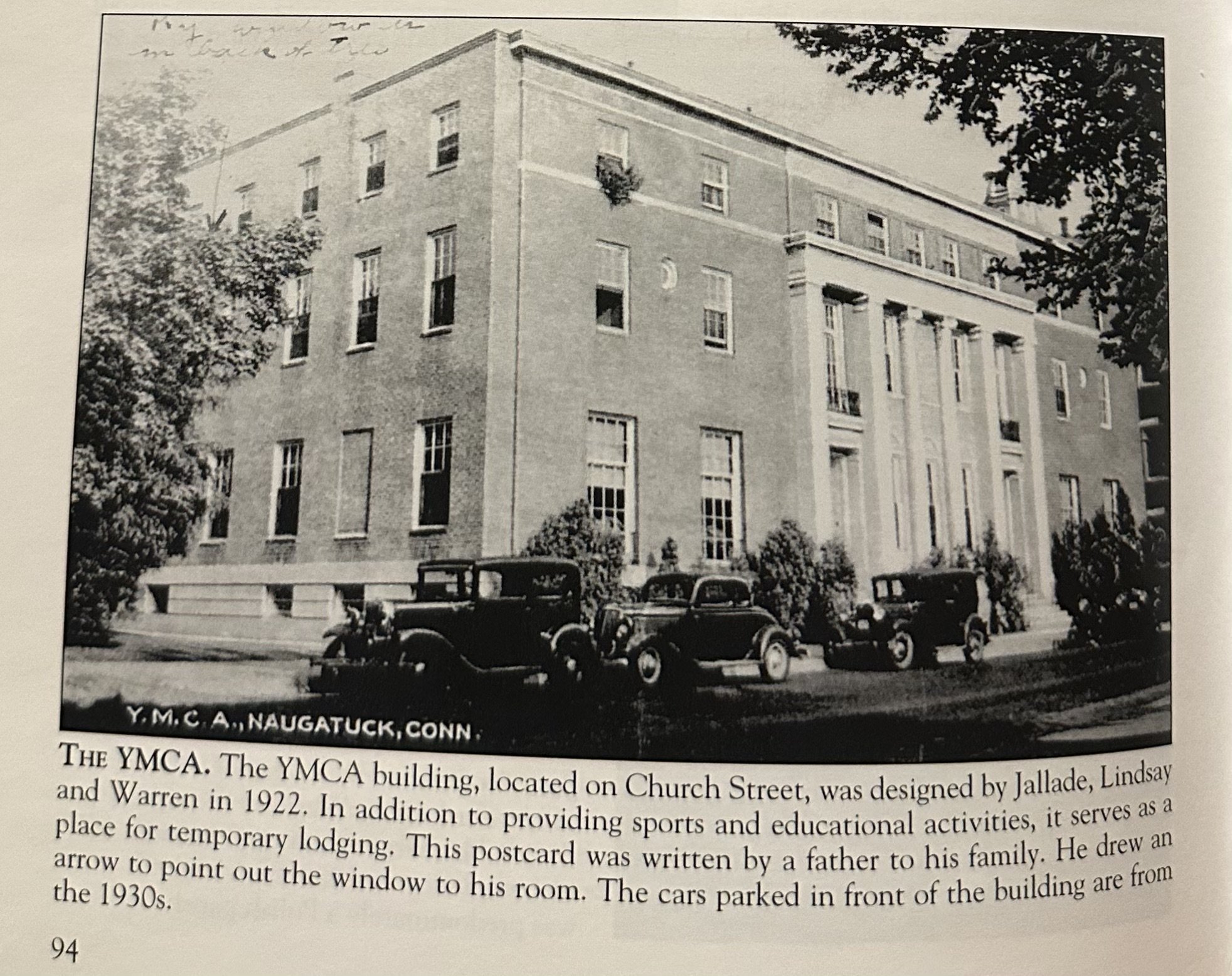
Images of America - Naugatuck & Naugatuck Revisited Dana J. Blackwell and The Naugatuck Historical Society (November 1, 1996) Ron Gagliardi (August 25, 2004)
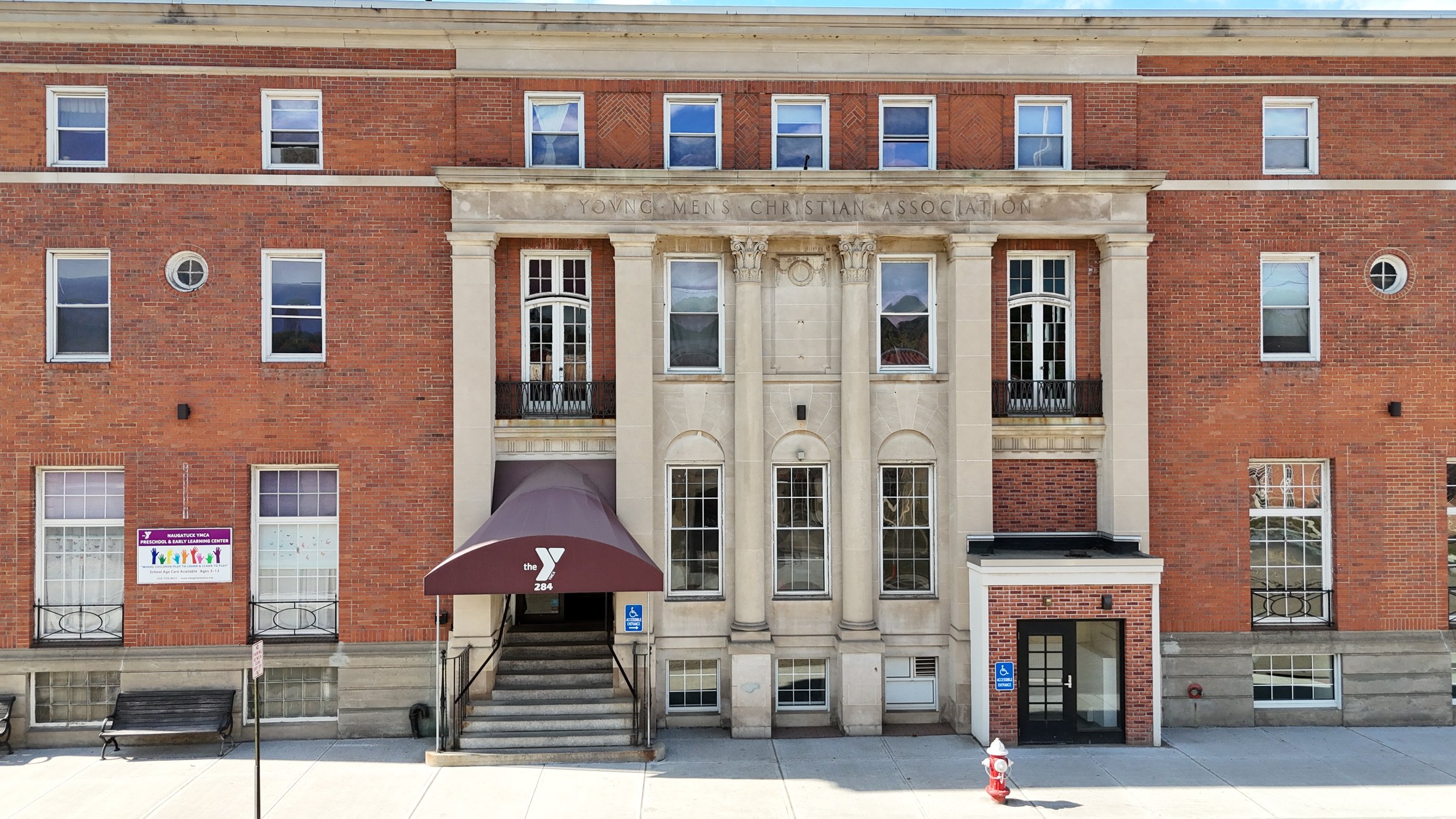
YMCA - 10/2024 Photo Credits: Taylor Bennett
The Naugatuck YMCA (and the Curious Case of the Colorado Church Window)
When the Naugatuck YMCA was first incorporated in 1895, its building sat along Water Street (see picture with red arrow) close to where Nardellis is today. The building remained in use until the present-day YMCA was built in 1922.
In 2005, the Naugatuck Historical Society was contacted by Historic Highlandlake (a small historical society near Mead, Colorado). They were restoring a church, c. 1895, that was built through the fundraising efforts of, then pastor, Mary Bumstead. The church features 3 large stained-glass windows. Two of the windows were memorials for locals and the third was a gift from the Naugatuck YMCA! Extensive research was done by Historic Highlandlake, the Naugatuck Historical Society and the Naugatuck YMCA to find out the story behind the window’s donation. The YMCA reported that the early Board of Directors minutes made no mention of the window and that the YMCA was a somewhat “frugal” organization. To this day is remains a mystery as to why and how the donation was made.
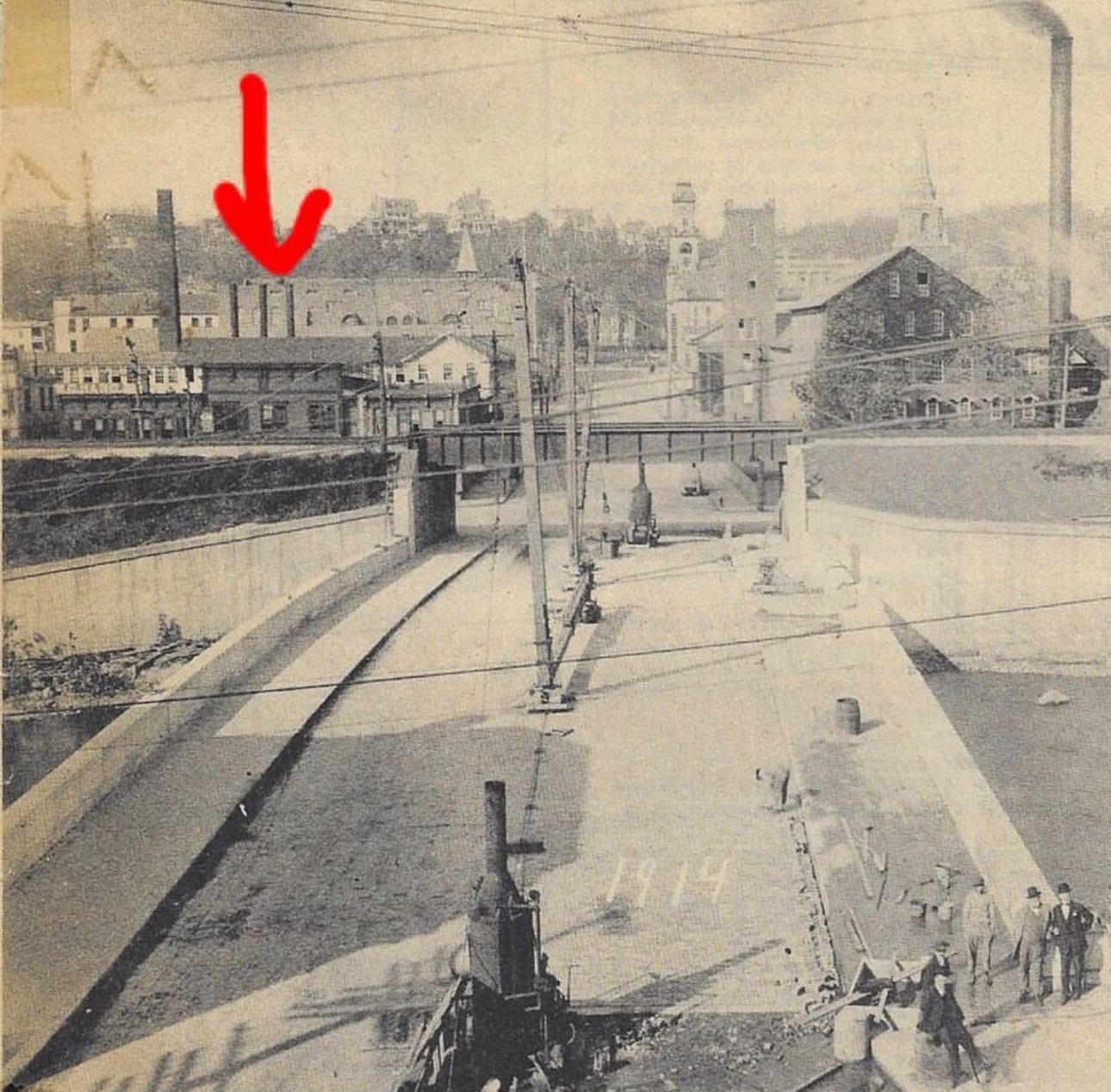
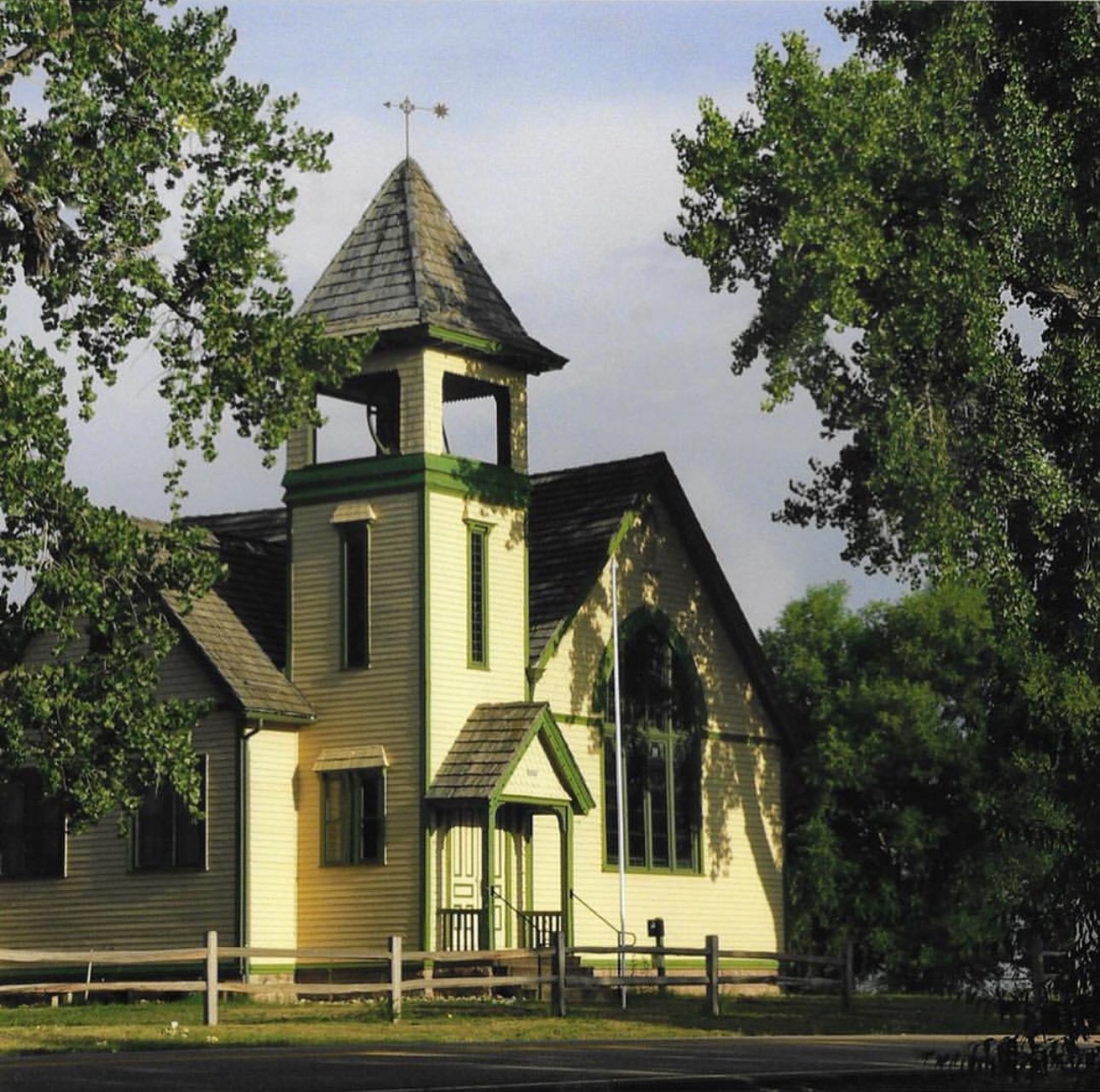
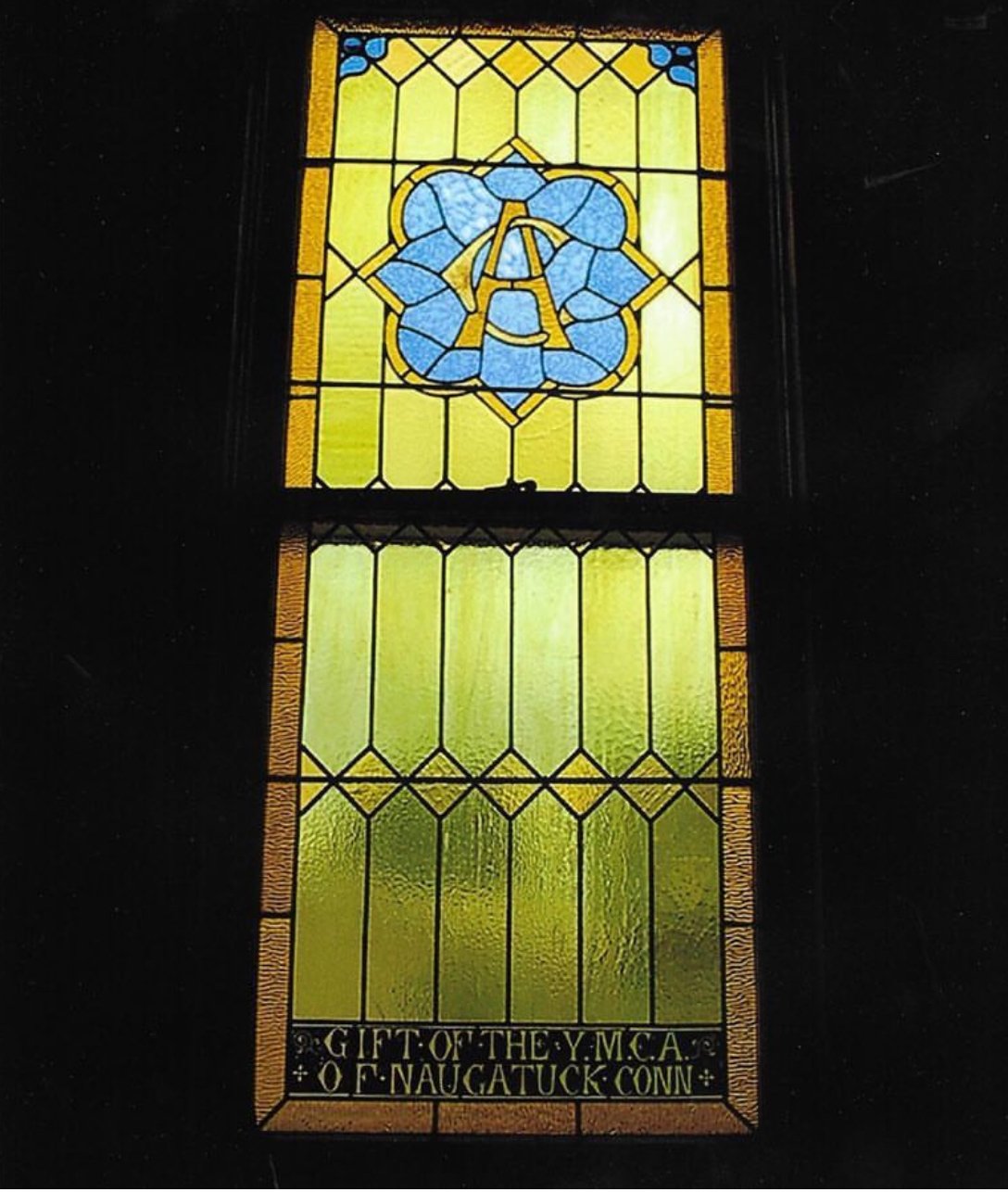
Excerpt from Naugatuck Daily News – Saturday, August 31, 1946
World War II - History Edition
YMCA Center Of War Activities Headquarters For Casualty Unit
Servicemen Home On Leave Found All Facilities At Free Disposal
The Y M C A played its part during the war emergency years in serving the military personnel, industrial workers, and their families, keeping our youth engaged in worthwhile activities, and by making Y M C A facilities into emergency needs.
Headquarters for the Emergency Casualty Center was the Y. M. C. A. cafeteria and kitchen. The local Casualty Center was rated among the highest in the state. It was equipped to take care of over 300 casualties.
The Red Cross sewing, knitting and fair aid work were carried on in one of the Y M C A rooms during the war.
All servicemen home on leave were extended free use of the Y. M. C. A. facilities such as the gymnasium, swimming pool, games, etc. They also could participate in “Y” programs in Naugatuck. n most communities throughout the country, the U. S. O. helped to carry some of the expense involved in these services but locally the Y M C A carried the costs for such services.
The Y M C A was the center for many War Emergency Committee Meetings. Every week there were numerous meetings of groups preparing their specific assignments for War Emergency work.
Headquarters for the Blood Donors Bank were at the Y M C A where club rooms, lobbies, cafeteria, and gymnasium space were set aside to make provision for the work carried on in securing the blood donations of our local people.
Water safety courses were conducted along with life saving classes to help people to be prepared for emergencies.
All of the second floor club rooms were taken over for use in emergency housing of war workers in order to provide living quarters for workmen coming to Naugatuck factories.
Probably the greatest service rendered during these trying years was that of providing wholesome, healthful programs for the boys and girls to build strong bodies, good character, and to keep the morale of our young people high. During the last of the year, Teen Canteen was organized for the young people of High School age to provide opportunity for social activity and dancing.
Many opportunities for counseling with Service Men on their personal problems were met wholeheartedly by the Y staff members.
Excerpt from Naugatuck Daily News – Saturday, August 31, 1946
World War II - History Edition
Two Surgical Tables, Fifty Cots Set Up
Mrs. Edith Lalor Has Perfect Record Of Attendance At Drills
The grim possibility of casualties requiring full medical and surgical facilities was not overlooked in the setup of the Naugatuck Defense Council. A model medical division, directed by Dr. N. A. Towne, was the boast of the borough, complete with 50 cots, two operating tables and full equipment for operations—even to batteries to substitute for electric current if necessary.
The medical center was located at the YMCA.
Dr. Walter I. Baker resigned as chairman of the medical division of the council in February, 1942, becoming assistant chairman under Dr. Towne.
Defining the responsibilities of Dr. Towne and estimating the hours of his time spent in the intelligent and conscientious devotion to these responsibilities would be impossible. Briefly, he carried out a program of recruiting doctor, nurses and aides; of training, equipping and assigning duties to his full force of volunteers; of cooperating with the evacuation unit, the Red Cross, state and local health officials, and with officials of industry and schools. This in addition to the selecting and providing for equipment of an emergency casualty station, all in the effort to provide the speediest and the most efficient medical service in any war-caused emergency that might arise.
Trained Nurses
One of Dr. Towne’s first steps was to request all available trained nurses to register for service with the medical division. Many volunteered, and at a meeting they chose Mrs. Edith Lalor as leader of their unit.
Doctors
Doctors working with Dr. Towne in the medical division were Dr. Vincent P. Duffy, Dr. David Bluestone, Dr. Baker, Dr. William Hill, Dr. Edwin Curran, Dr. Seymour Bonn, Dr. Charles Kennedy, Dr. Walter Reilly, and Dr. Victor Casella.
Dentists were Dr. E. Lerman, Dr. Everett T. Rogers and Dr. Henry Gordon. Other volunteers included Dr. Arthur Anderson, chiropractor, Dr. Philip Cohen, optometrist, Alanson Benson, Mrs. Elsie Canidee, Mrs. Sophie Conover, Mary E. Foley, Mrs. Edward Hermonat, Betty E. Stinson, Jean E. Stinson, Rose Bess Thomas and members of the Girl Scouts and Boy Scouts.
In the 27 air raid tests during the fearful war years nurses served with distinction. Mrs. Lalor held a perfect record of attending every one of the 27 tests. Others who were at their posts for ten or more tests included Mrs. Doris Kwasniewski, Mrs. Fridolf Carlson, Mrs. Thomas Scally and Mrs. Dorothy Olson.
The other 22 registered nurses who served included Mary Claffey, Katherine Brooks, Anna Doran, Julia Youle, Adeline Minicucci, Mary St. John, Mrs. Margaret Foley, Mrs. William Birdsall, Mrs. Moore, Mrs. Grace Bluestone, Mrs. Eleanor Pigaty, Mrs. Madeline Mary Fitzgerald, Mrs. Ann Hogan, Mrs. Clara Sadosky, Mrs. Elizabeth Murtha, Mrs. Jeanette St. John, Mrs. Alice Ratkiewich, Mrs. Ann Austin, Mrs. Bernice Sweeney, Mrs. Mary Schofield, Evelyn Jones and Agnes Gormley.
Mops and Brooms
Actual establishment of the emergency casualty station in the Y. M. C. A. might have been long-delayed had it not been that Mrs. Lalor and her loyal assistants gathered mops, brooms, scrub pails, buckets and other utensils, and with hours of real labor turned the long-unused cafeteria and kitchen of the YMCA into a spotless center for emergency medical care.
Walls were painted, cupboards were readied and supplies were moved in—surgical instruments, dressings and bandages, heating pads and splints—two fine operating tables with powerful battery lights to be used in the absence of electrical current. Emergency, portable supply cases were ready for teams to take on field calls.
Separate wards for men and women were set up. Fifty cots were moved in, blankets, pillows, pillow arranged by Mrs. Lalor and her assistant, and many volunteers of the Red Cross.
First Test
The emergency casualty center was equipped and operating when the first air raid test was held on March 1, 1942. Panel trucks for ambulances, first aid teams, all functioned with speed and efficiency throughout the period of air raid tests.
The casualty station was put to actual use for the first time August 24, 1942, when local doctors and nurses assisted with the first local donations of blood to the plasma bank.
The center was used for the same purpose many times during the war.
Excerpt from Naugatuck Daily News – Monday, September 15, 1947
Industrial Exhibit Supplement
YMCA Serves Whole Family In Naugatuck
The future of any city depends upon its youth. Today’s young people of Naugatuck will be tomorrow’s leaders and it is essential that the youth be provided activities that encourage them to develop clean minds and healthy bodies. Right habits of thought and action are vital in training for useful citizenship.
The aim of the Y.M.C.A. is to help youth prepare for life by sponsoring wholesome programs with adequate facilities and leadership so that these objectives may be reached.
The Naugatuck Y.M.C.A. serves the whole family. Brother, sister, mother and dad. Thousands have developed and maintained healthy bodies and developed skills through the Y.M.C.A. physical education program.
Hundreds of boys and girls have gained fellowship, character and citizenship training through club groups, crafts and hobbies. Young people have enjoyed social activities, parties and dancing at the local Y.
Many adults, both men and women, enjoy gymnasium classes, swimming classes, bowling leagues, etc., as healthful recreation in keeping physically fit.
The Y is a home away from home for young men employed in our local industries.
Industrial workers are served the year around through a recreational and social program under the Naugatuck Y.M.C.A. Industrial Council.
A large number of service-minded people serve as directors, committeemen, and group leaders in carrying out the program of the Young Men’s Christian Association.
A great many community organizations look to the Y for a place to meet and for helpful suggestions in their activities.
The Y.M.C.A. is an organization of its members for its members wherein the Y members themselves plan and organize the programs that they want to participate in. They elect people to direct the association and through their directors, trained leaders are engaged to help the members carry out the activities in which they want to take part.
A very large percentage of our local families are served or reached by the Y as indicated by the size of the membership which numbers close to 1300 men, women, boys and girls. Hundreds more, though not present members, are reached through Industrial and Community programs sponsored by the local association.
World-wide in its scope the Y.M.C.A. movement serves in 69 countries around the globe with each local unit having its own autonomy but inter-related in purpose and objectives.
General MacArthur speaking on building a lasting peace said “The problem basically involves improvement of human character. It must be of the spirit if we are to save the flesh.”
The Association purposes are directed toward such goals as would make for a peaceful world in which people understand, respect and serve one another.
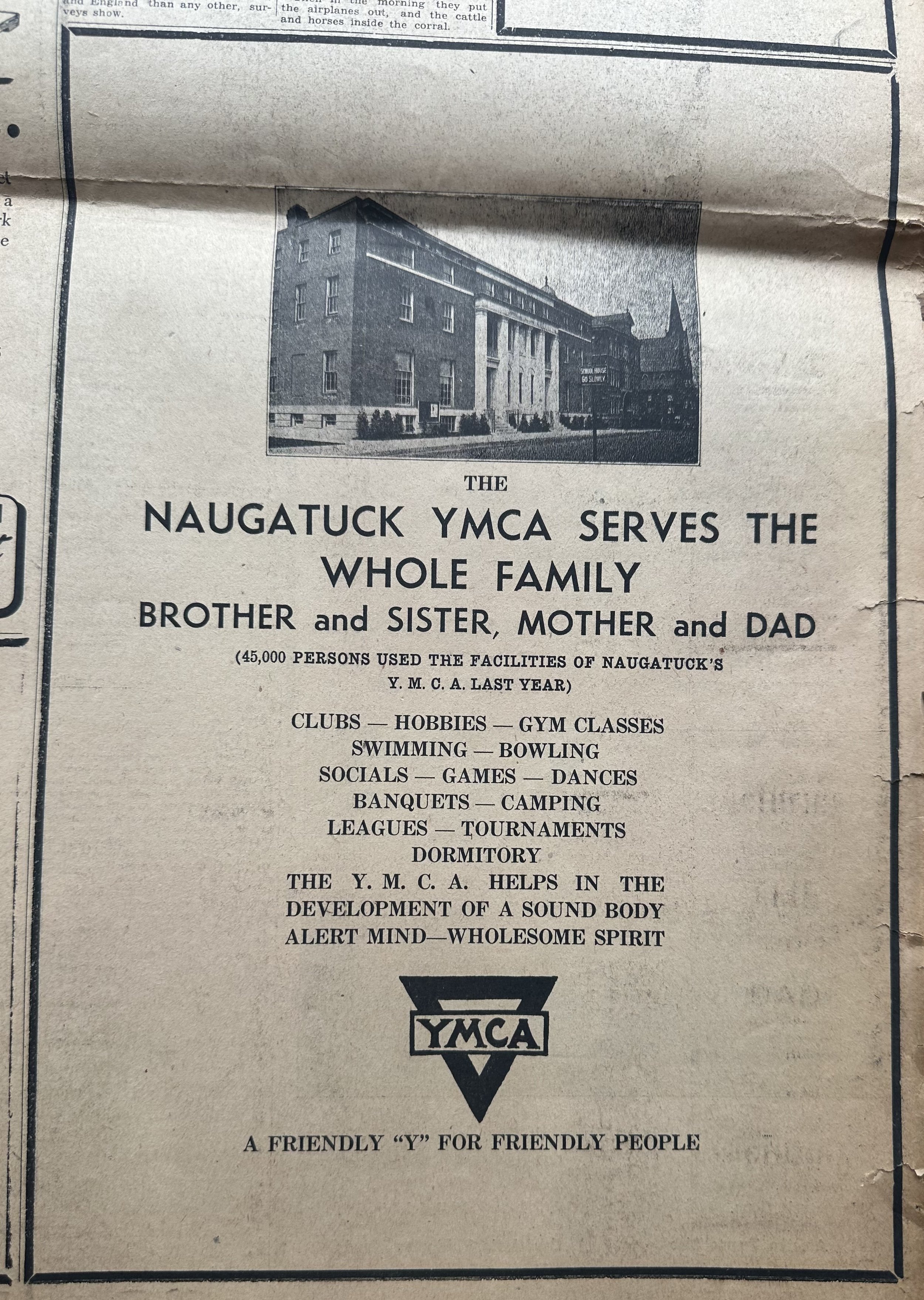
Naugatuck Daily News – Monday, September 15, 1947
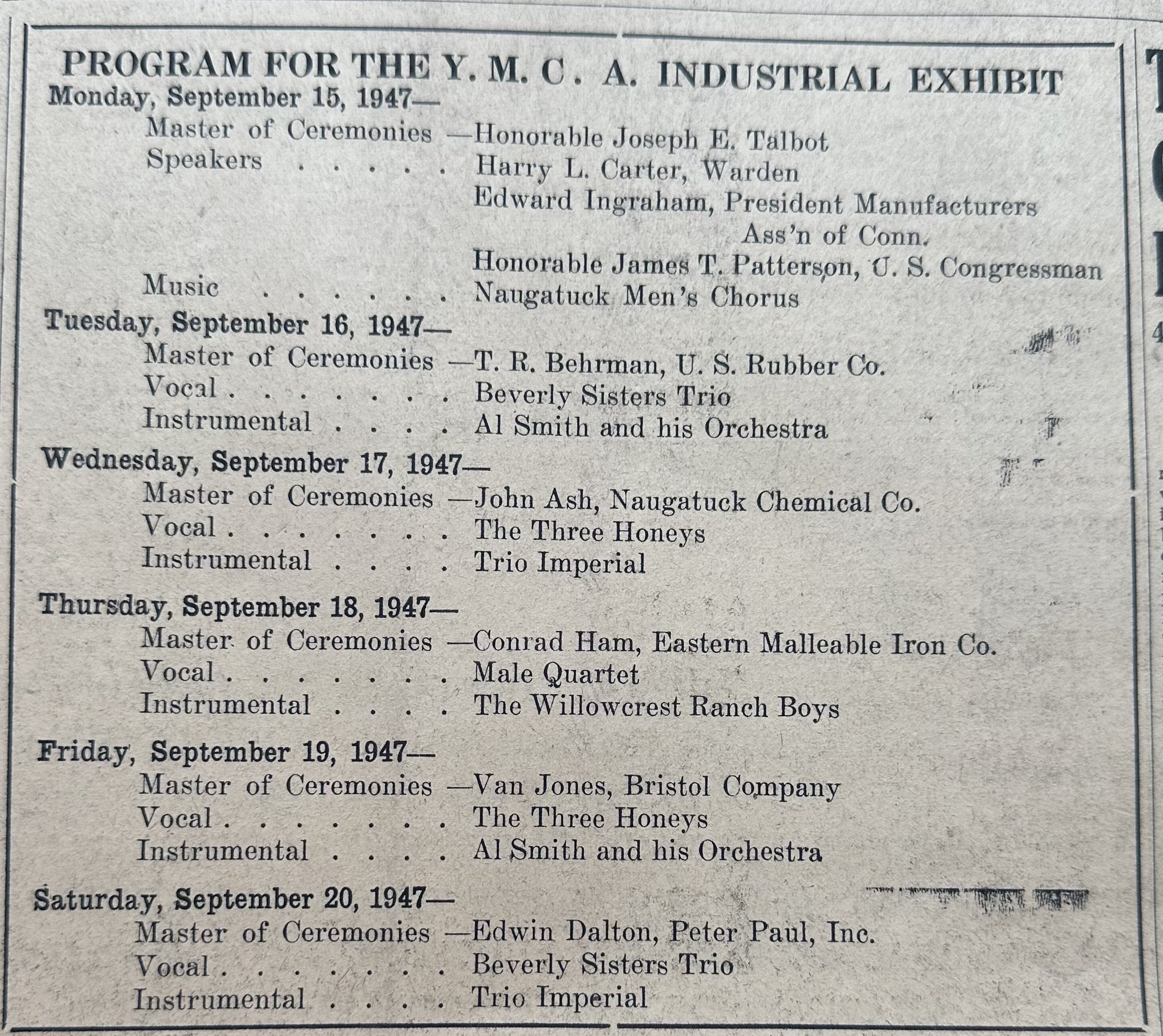
Naugatuck Daily News – Monday, September 15, 1947
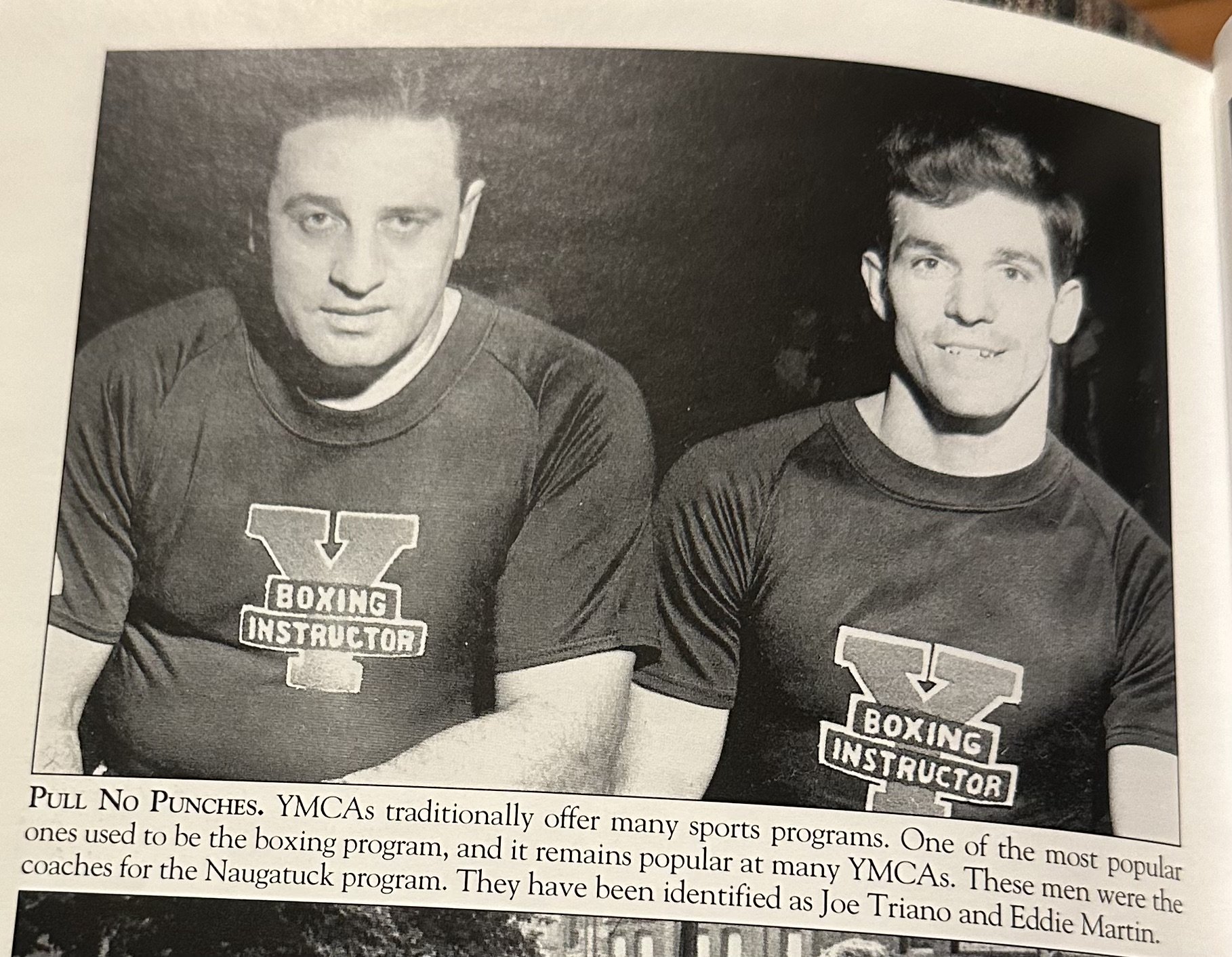
Images of America - Naugatuck & Naugatuck Revisited Dana J. Blackwell and The Naugatuck Historical Society (November 1, 1996) Ron Gagliardi (August 25, 2004)
